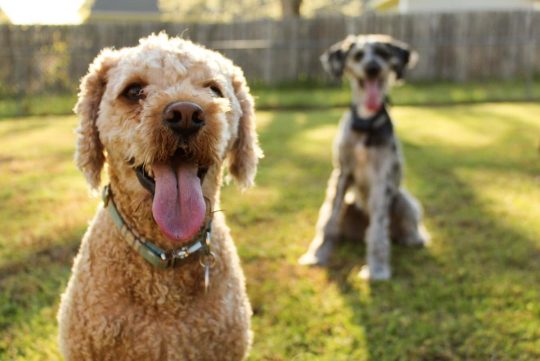Precautions
Before adding another dog to your household, you should consider how your dog would react.
It can take anything more than 6 months for a dog to adjust to a new environment, so it’s important to make sure your dog has settled into your home before introducing a second.
First things first, you must make sure that your new dog has had all the relevant vaccinations – the last thing you need is both dogs to get sick.
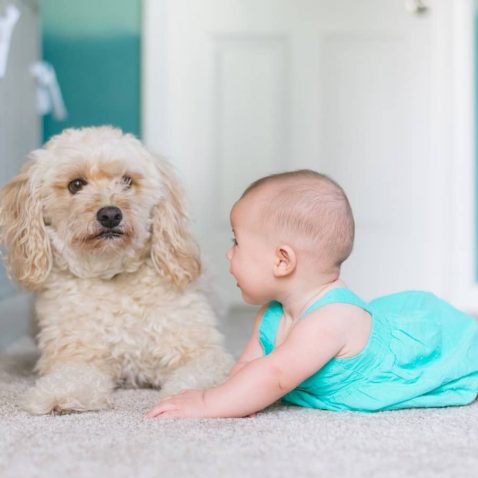
The Right Dog
If you’re still making your decision on what type of dog you want to add to the family, consider the breed, age, and personality of your potential new dog.
If your current dog is assertive and dominant, adding another dominant dog may cause tension in the household, which could lead to aggression.
Size is also important – if you have a huge dog, introducing a tiny chihuahua may not be the best option.
Consider how old your dog is. Older dogs and younger dogs can be super compatible, a hyperactive young pup may stress out or irritate an older dog.
If you know whether your dog gets on better with male dogs or female dogs, then consider that. In most circumstances, the combination of a male and a female is best.
If Your Dog Has a History of Aggression
If either dog has a history of aggression, it’s important that you think twice before introducing them.
If you’re set on the decision to get a new dog, then consider the temperament of the new dog. Try to make sure that he has a steady temperament, and isn’t too energetic – as this could provoke your current dog.
Don’t be afraid to seek help from a dog behavior consultant if you’re worried or have any concerns about introducing a new dog to your aggressive dog.
The First Meeting
When you’re introducing two dogs for the very first time, it’s important that both dogs have their own handler.
The ideal scenario is to introduce them both on leashes in an unfamiliar, outdoor environment.
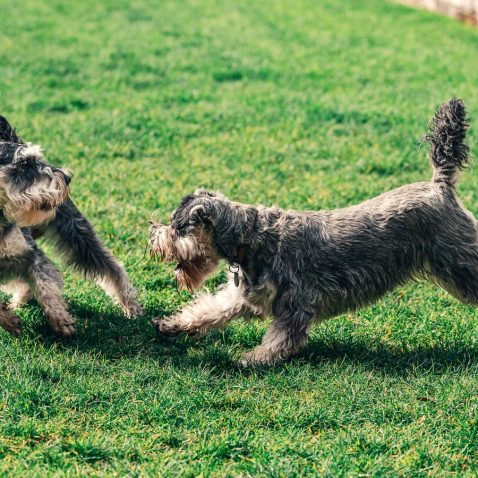
Neutral Territory
To avoid territorial anger and defensiveness, introduce your dogs on neutral territory. One of the best ways to first introduce dogs is by taking them both on a walk on a leash.
When choosing a walking location, consider taking an alternative route. If your dog is already familiar with the setting, then he may feel some ownership over the area and therefore be territorial.
Be sure to choose somewhere that neither dog has a connection with.
Walks are hugely important to dogs. Dogs are pack animals, and walks are crucial to building the bong within the pack.
Usually, the alpha leads first, so make sure you lead the dogs and they follow behind, or heel.
Once your dogs have had a good sniff of each other, let them loose with the leash still on them (this works best if they are both trained).
Let them play for a few minutes, and observe their behavior (see Chapter 3: Observe Body Language) and then end the session.
Daily, routined walks will establish a bond between the two dogs in no time. The dogs should learn to respect you and your leadership while getting along with one another.
If you’re short of time, introduce your dogs in a room of the house that your current dog isn’t allowed in, or doesn’t have access too.
This will put them both in the same situation – they’re both in an unfamiliar place so there shouldn’t be any territorial issues.
Observe Body Language
When two dogs are getting to know each other, you must stay alert and keep a close eye on both dogs.
Yes, dogs can be unpredictable, but they do show signs before they attack.
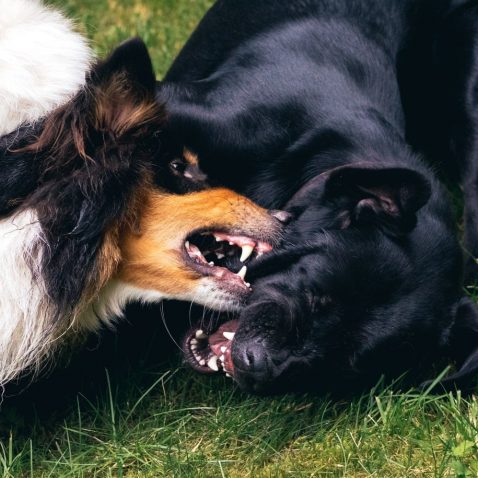
Signs That They’re Having Fun:
- Open-mouthed grin (not to be confused with teeth-baring)
- Over the top, bouncy movements (being silly)
- Exposing their bellies to each other (being vulnerable)
- Play fighting (usually louder than real fighting)
Your dogs need to have these interactions if they want to cohabit. Unless either dog is in danger, try not to intervene – let them have their interactions and learn social lessons from each other.
Signs That Your Dogs Aren’t Getting Along:
You must separate your dogs immediately if either one is showing any of these signs, as they could be ready to attack:
- Hair standing up on your dogs back
- Teeth baring
- Growling
- Stiff posture
- Prolonged stare
- Quick and efficient movements
- Showing the whites of their eyes
- Ears suddenly flattened or pricked up
Signs That Your Dog is Uncomfortable
It’s important to keep an eye on your dog, as an uncomfortable dog could lead to an aggressive dog or a scared dog. When dogs get scared, they can get traumatized – which can be irreversible.
Keep an eye out for the following signs – if your dog shows these signs then it’s time to split them up, give your dog lots of love, and try again another time:
- Slow wag of tail or tucked tail
- No appetite
- Doesn’t seem playful
- Holding his breath
- Pinned back ears
- Blinking more frequently
If It Isn’t Going Well
If you see your dog showing any of the signs listed above, make sure you firmly say “NO” to the offending dog.
Separate the pair, and try again another time. Give them time to get out of the mood cycle, and try again in either the next few hours, or the following day.
Any positive signs in the process, be sure to reward. Give them a reward – a stroke, play or a treat will positively reinforce their friendly behavior.
If your dogs are full-blown fighting, they should be separated to prevent further injury.
It’s best not to grab your dog by the collar, as this could result in the dog biting you. It’s always best to have a handler for each dog – as it can take two to separate a dog fight.
If you’re unable to handle the situation, it may be worth contacting a trainer to ask for advice, or to train your dogs.
The Wheelbarrow
One of the safest methods you can use to break up two fighting dogs is the “wheelbarrow”.
Each person grabs a dog’s back legs and lifts them off the ground, and pulls them back away from each other.
This must be done immediately, as dog fights can be dangerous, and sometimes even fatal.
In the Home
Arrangements need to be made in the home before introducing a new dog to your household.

One of the first steps you should take is removing all toys and treats lying around – anything that the dogs may fight over needs to be put away until a later time.
Before bringing your new dog into your home, it’s recommended to allow the dogs to meet in the yard first.
Take your current dog into the yard, and while he’s outside, bring your new dog inside. It can cause an unwanted reaction if you bring your new dog inside straight away – so be sure to keep the introduction process slow and steady.
During the first few weeks, stay cautious and keep an eye on your dogs. Try not to leave them alone together until you’re certain that they are comfortable with each other.
It may be worth purchasing a baby-gate to separate certain rooms, just until your dogs form a bond.
Observe how your dogs react between the gate, and keep it there until you’re comfortable putting them together.
Learning
Your new dog has a lot of lessons to learn if he wants to fit into the household. Puppies especially have a lot to learn, but not just from you.
Your dog will need to learn from your other dog – puppies especially can lack social skills, and each interaction that the puppy has with other dogs will increase his social understanding.
For example, if a hyper puppy is pestering your older dog, your dog may growl at the puppy. This isn’t something that you should punish – it’s simply a lesson for your puppy to learn.
Your puppy needs to learn when to take a step back from the situation. Try to only intervene if either dog is in danger.
Preventing Conflict
When you’re not there to watch over them, be sure to keep them separate until you are comfortable enough to leave them together.
Separate rooms is the best option, but if that isn’t an option for you, then try putting them in separate crates.
This will not only prevent your dogs from fighting with each other, but it will also prevent your new dog from developing destructive traits like chewing or going to the toilet on the floor.
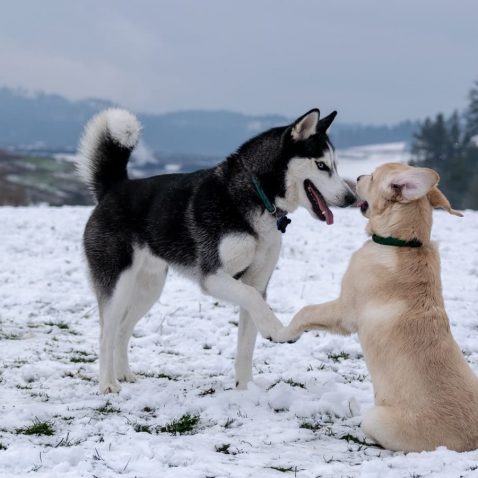
Exercise
One of the most important things you can do to reduce the risk of conflict in the household is ensuring that all of your dogs get plenty of exercise.
Exercise is vital for your dog’s wellbeing, and lack of exercise hugely increases the chance of behavioral issues.
If your dogs are going to be stuck in a small space together and they aren’t familiar with each other yet, it most likely won’t end well.
Make sure both dogs have a decent sized walk a day with enough freedom to run around and tire themselves out. Any pent up energy may present itself with anger.
Reward Positive Behavior
Using positive reinforcement is just rewarding the behaviors you want to see more of, and trying not to acknowledge the bad behaviors.
If you see your dogs getting along, be sure to reward them with affection or with treats. This kind of reinforcement will make your dogs more likely to repeat this behavior – dogs aim to please!
The key to positive reinforcement is keeping consistent and patient – it can take a while before you see improvements in your dog’s behavior, but keep at it and they’ll be friends in no time.
Summary
It can be frustrating trying to get your dogs to get along with each other, and it can be really hard to stop yourself from intervening.
It’s important to leave them to it unless they are in danger – for puppies especially, this is a learning curve and your dogs will need to adjust to this change in their own time.
If you have any concerns or queries, don’t be afraid to contact a professional dog trainer or a dog behaviorist.
Have you got any tips for introducing dogs that you want to share with us? What are your thoughts on our guide? Let us know in the comments below, and don’t forget to share this with your fellow dog-lovers.
Good luck!
Share the Love
If you found this post useful, please let others know about it by sharing it.
